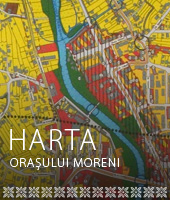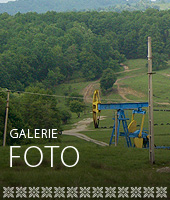Events Calendar
vizite
Villages with households scattered in the border contents have emerged across town Moreni, especially after 1864. Their appearance should be closer link to the farmland for better care and capitalizing on them, given that their situation is clăcaşi changes landowner by agrarian law of Cuza.Changes in the border village can stand several causes (eg "Tisa" was included in Moreni by building housing close to Stavropoleos than Ciocoieştii COLIBAŞI; Schela Mare returns by dividing ad-territorial Moreni 1968 border with Gura Ocniţei stabilindu- is through understanding among secretaries of People's Councils that time).
A village has its roots formation of habits, customs and practices, imbedded deep in centuries past, keeping up this treasure in our times which by passing from generation to generation, it becomes tradition. Unfortunately industrialization shook the area early tradition that could not be kept any documentary, bringing a decisive rupture in people's life and work.
An interesting phenomenon is also the extension of to surface. The household demanding an expansion area to match its maximum production role, the settlement comprising a conglomerate of households was extended in particular to the periphery (as occurred minicartierul "Tisa" or habitable zone "gardens"). For common Moreni a specific phenomenon is the emergence of "colonies workers" to virgin areas, especially the forested.("Pâscov", "Steaua", "Schela Mare", "Creditul Minier"), or in the center of Stavropoleos (colony"Astra Română").
The household residents come from villages morenare has so many differences as outcome to find the most suitable plans, which offer the best conditions for household and domestic carrying out the activity. There were specific aspects of the organization of the village and industrial development of the village until 1947. Thus, by about 1970 the hearth of it were in town with longer properties with long strips of land, narrow street facade, through inheritance and desired results as "home place". By systematizing imposed after 1970 to Moreni there were units with outputs oblique to the street and construction of special charm but lacking any aesthetic taste, with upstairs or back home.
After 1970 new constructions and assemblies rural blocks have changed in appearance since the central part of the settlement. Systematization plan approved after 1985 and intended to transform Moreni into an urban"socialist" predict changes to areas "Bl.Republicii" street "Victoria" to the old town hall, the colony "Romanian Astra" current "Bl. December 22 ". The political change in 1989 replaced systematization plan with a new policy towards housing construction type "individual case". Lately put a reorganization of urban activity and systematization resulting from changing land ownership and the need to find appropriate construction of a "city for the third millennium".
Typology of settlements was adapted working conditions and living conditions, being directly influenced by demographic trends.
Since before 1840 Morenii were part of Filipeşti place, under a ruler whose residence in Filipeşti Fair. The commune was governed by elected village.
In a work published in 1868 is reminiscent of that city alongside Diţeşti Moreni, Filipeşti, Mărgineni and Iedera de Jos form "Plaiul Filipeşti".
A bit later, Morenii is remembered as a village in the county of Prahova, Filipeşti forming a common place with the hamlets Cornesci, Descindeni, Stavropoleos and Tisa. It has a population of 1,040 inhabitants and 17,000 acres of forest. In 1876 Morenii was in place Filipeşti commune Ghirdoveni, along with villages Braniştea, Cricoveni, Ghirdoveni, Haimanale, Monastery, Moreni Negra, Piscuri, Pleaşa, Rapa, Stavropoleos, Tisa, Tuicani the last 8 locations being villages across current Moreni.
In 1897 the commune Moreni is made up of villages Moreni, Tisa - Stavropol, Tuicani and Pleaşa, as in 1912, the prefecture Prahova indicate that in Filipeşti, Moreni village, are common following locations: Moreni, Pleaşa, Stavropoleos Tuicani, Tisa. The census recorded net Smelly city Tisa which apparently belongs to Gorgota - Ştiubee and Tisa village is not the right Cricovului. A map from 1902 includes Morenii to Iedera alongside Colibaşi, Stavropoleos Ciocoieşti, Ruda, Tisa, Pleaşa, Tuicani.
In 1930 Tisa hamlet, village belongs to Stavropoleos that in 1931 becomes a separate joint in Prahova County and villages including Tisa, Tuicani and Pleaşa.
On 17 September 1947 the union of the village commune Stavropoleos Moreni Moreni city appears, with the town hall in the building built in 1936 in the industrial area Stavropoleosului.
Following the socio-political changes since its last World War, the city became the residence Moreni net with the same name (1948-1950).
Decision of C.C. P.C.R and of the Council of Ministers regarding the new economic administrative division of country into districts decide that Moreny City to belong to Campina.
On February 16, 1968 the Grand National Assembly votes the law on the administrative organization of the territory R.S.R. city Moreni including district workers Schela Mare (until then part of the village Gura Ocniţei district Targoviste), becoming the second most important city in Dambovita County. Then administrative status is maintained today, desperate efforts during the country's administrative status change, which sought, argued Morenii inclusion in Prahova County, being forgotten by today's generation. The evolution of settlements in being area Morenii mainly related to economic and demographic factors resulted to a permanent element of curiosity and analysis.










